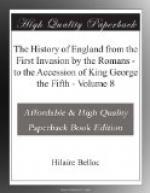Having added, at the suggestion of Dr. Juxon, “I die a Christian according to the profession of the church of England, as I found it left me by my father,” he said, addressing himself to the prelate, “I have on my side a good cause, and a gracious God.”
BISHOP.—There is but one stage more; it is turbulent and troublesome, but a short one. It will carry you from earth to heaven, and there you will find joy and comfort.
KING.—I go from a corruptible to an incorruptible Crown.
BISHOP.—You exchange an earthly for an eternal crown—a good exchange.
Being ready, he bent his neck on the block, and after a short pause, stretched out his hand as a signal. At that instant the axe descended; the head rolled from the body; and a deep groan burst from the multitude of the spectators. But they had no leisure to testify their feelings; two troops of horse dispersed them in different directions.[1]
[Footnote 1: Herbert, 189-194. Warwick, 344. Nalson, Trial of Charles Stuart. The royal corpse, having been embalmed, was after some days delivered to the earl of Richmond for private interment at Windsor. That nobleman, accompanied by the marquess of Hertford, the earls of Southampton and Lindsey, Dr. Juxon, and a few of the king’s attendants, deposited it in a vault in the choir of St. George’s chapel, which already contained the remains of Henry VIII. and of his third queen, Jane Seymour.—Herbert, 203. Blencowe, Sydney Papers, 64. Notwithstanding such authority, the assertion of Clarendon that the place could not be discovered threw some doubt upon the subject. But in 1813 it chanced that the workmen made an aperture in a vault corresponding in situation, and occupied by three coffins; and the prince-regent ordered an investigation to ascertain the truth. One of the coffins, in conformity with the account of Herbert, was of lead, with a leaden scroll in which were cut the words “King Charles.” In the upper lid of this an opening was made; and when the cerecloth and unctuous matter were removed, the features of




